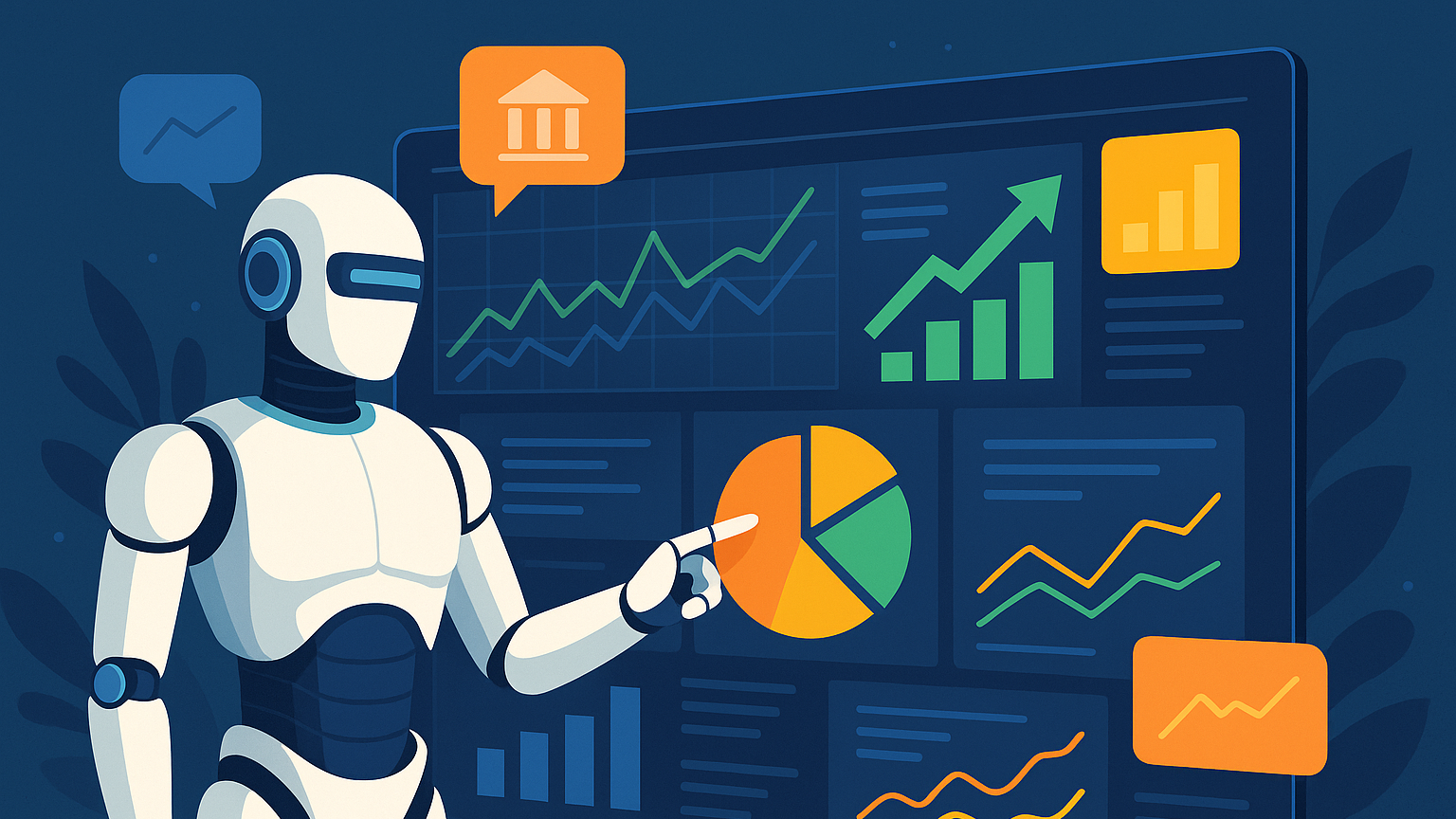
Robotic process automation for financial communications and AI awareness for business leaders
You’re living in a moment when automation and artificial intelligence are rewriting how financial communications work. If you lead a team, a department, or an entire company, you need practical awareness about what AI and robotic process automation (RPA) can do for your communications and reporting workflows. This article walks you through what RPA is, how it intersects with advanced analytics and AI, relevant use cases across functions and sectors, implementation steps, governance and risk considerations, and how you can start getting wins quickly. The goal is to make you more confident in applying these technologies so you can increase productivity, reduce risk, and improve stakeholder experiences.
Why this matters now for business leaders
You may already be feeling pressure from faster reporting cycles, greater demand for transparency, and the need to personalize communications to different stakeholder groups. AI and RPA let you handle higher volumes of work with fewer errors and more consistency. They also create new opportunities to surface insights and deliver tailored messages in near real time. If you don’t engage with these technologies proactively, you risk falling behind competitors who are already using automation to tighten control, speed up disclosure, and personalize investor interactions.


What is robotic process automation (RPA)?
You can think of RPA as software “bots” that mimic human actions across applications to complete repetitive tasks. These bots click, copy, paste, extract data, and move information between systems — just as a person would, but faster and without fatigue. RPA is not the same as full AI; it’s deterministic automation that follows rules, though it can be combined with AI components to handle more complex tasks. For financial communications, RPA specializes in consistent, rule-driven processes like preparing standard reports, populating templates, and moving regulatory filings through predefined workflows.
RPA components and how they work together
An RPA solution typically includes a designer (where you build process scripts), a runtime environment (where bots execute), and an orchestration layer (to schedule, manage and monitor bots). You’ll also integrate RPA with enterprise systems like ERPs, CRMs, document management systems, and analytics platforms. Understanding these components helps you plan the technical architecture and governance around automation so you don’t create operational silos or unmanaged bot sprawl.
How RPA transforms financial communications
RPA can be used to automate many steps in financial communications: compiling quarterly reports, extracting numbers from systems and populating web-ready templates, formatting investor presentations, submitting regulatory filings, and routing approvals. When you automate these tasks, you reduce manual errors that can damage credibility with investors and regulators. You’ll also accelerate cycle times and free your team to focus on interpretation, strategy, and higher-value stakeholder engagement.

Examples of tasks you can automate today
You can automate processes like extracting trial balance data for pre-close analyses, assembling the first draft of earnings releases from standardized inputs, anonymizing and redacting documents for public release, and distributing tailored disclosure packages to different investor segments. These are repeatable tasks with defined inputs and outputs — the sweet spot for RPA. By automating these, you’ll see immediate gains in accuracy and throughput.
How AI enhances RPA: intelligent automation
RPA becomes far more capable when you pair it with AI capabilities such as natural language processing (NLP), document intelligence, sentiment analysis, and predictive analytics. While RPA handles deterministic actions, AI can interpret unstructured data, extract insights, and make probabilistic judgments. For instance, AI can read earnings call transcripts to summarize key themes and sentiment, and then RPA can route those summaries to investor relations teams and update dashboards automatically.
Practical AI features to combine with RPA
You’ll find that integrating document OCR and NLP lets your bots process scanned financial statements or analyst reports. Sentiment models can highlight sections of a transcript that require immediate response. Predictive models can help prioritize investor outreach by likelihood to trade or escalate. These capabilities let you move from simply automating tasks to automating decisions and communications in a controlled, auditable way.
Advanced analytics integration for richer outcomes
When you connect RPA with advanced analytics and data visualization, you can deliver real-time, context-rich communications. Instead of sending static PDFs, you can automate the creation and distribution of interactive dashboards, scenario analyses, and personalized performance summaries. The analytics layer helps you provide a narrative that is backed by data-driven insights, giving you stronger credibility with stakeholders.

Why analytics matter for your communications
Analytics give you the evidence to explain your business story. They help you detect anomalies, track key performance indicators, and support forward-looking statements with scenario modeling. Integrating analytics into automated workflows ensures that every communication — from investor decks to regulatory filings — is consistent with the numbers and the underlying assumptions you’re using across the organization.
Use cases by function and sector
You’ll get the most traction when you map RPA and AI use cases to specific functions and industry challenges. Below are detailed examples you can relate to your own area.
Corporate finance and accounting
In corporate finance, you can automate account reconciliations, accident-prone data entry tasks, and parts of the close process. RPA can pull balances, match transactions, and flag exceptions for human review. AI-enhanced automation can analyze transaction patterns to detect unusual items and suggest likely accounting classifications, speeding the close while improving control.
Financial planning & analysis (FP&A)
In FP&A, you’ll benefit from automating data aggregation and variance analysis. RPA can collect forecasts from business units and consolidate them in a central model. AI-driven forecasting models can augment human judgment and run hundreds of scenarios rapidly. This combination lets you produce more frequent, accurate forecasts and deliver tailored narratives to business leaders.
Investor relations and earnings communications
For investor relations, you can automate the assembly of earnings materials, manage distribution lists, and monitor social and analyst sentiment in real time. NLP can summarize Q&A from earnings calls and RPA can push those summaries to your CRM, ensuring investor-facing teams stay aligned. You’ll be faster in responding to market concerns and more consistent in your messaging.

Treasury and cash management
Treasury teams can use RPA to reconcile bank statements, execute routine payments, and trigger hedging actions based on predefined thresholds. AI models can forecast cash flows with a higher degree of accuracy by ingesting external signals (like market movements). Together, they reduce operational risk and support timely, transparent communication with stakeholders about liquidity.
Compliance, regulatory reporting and risk
RPA can standardize the preparation and submission of regulatory reports, while AI helps validate data, detect outliers, and interpret regulatory text for changes. You’ll reduce the risk of late or inaccurate filings and be better prepared for regulatory inquiries. Automated audit trails also make it easier to demonstrate compliance during inspections.
Banking, insurance, and asset management specifics
If you operate in banking, you’ll use RPA to automate KYC checks and client communications. In insurance, RPA and AI can speed claims adjudication and communicate status updates to policyholders. Asset managers can automate performance reporting, client portal updates, and compliance checks. In each case, you’ll improve response times and reduce manual backlogs that hurt client experience.
Implementation roadmap for business leaders
You don’t need to do everything at once. An effective implementation roadmap will help you prioritize and scale. You should begin with a clear strategy, a prioritized backlog of processes, a small pilot to prove value, and a Center of Excellence (CoE) to manage standards and reuse.
Steps to build your automation program
Start by mapping the end-to-end processes that underpin your communications, identify high-volume, rule-driven tasks, and estimate expected savings. Run a short pilot to validate assumptions, then define governance, roles, and escalation paths. As you scale, create reusable components and documentations so bots don’t become orphaned. This approach keeps risk manageable and accelerates adoption across the organization.
Governance, control, and auditability
You need governance frameworks to manage bots, data access, and decision logic. Automations must have defined owners, version control, a test environment, and audit logs. These controls ensure you can explain how a communication was produced, which is essential for regulatory compliance and stakeholder trust.
Operational controls to put in place
Ensure your RPA platform can provide an audit trail, role-based access, and a schedule for periodic reviews. Build a test and staging environment so changes can be validated prior to production. Also, require a sign-off process for any automation that affects external communications. These steps will protect your reputation and reduce compliance risk.
Data security and privacy considerations
Financial communications frequently involve sensitive data. You must handle this data with strong encryption, strict access controls, and secure credential management. Bots should operate with the least privilege necessary and all data movement should be logged and monitored.
Practical security measures
Adopt encryption in transit and at rest, implement multi-factor authentication for critical systems, and segregate duties so bots can’t be modified by unauthorized users. Conduct regular penetration testing and review retention policies to ensure you meet data privacy obligations under regulations like GDPR or industry-specific rules.
Organizational and people implications
Automation changes jobs and workflows. You should prepare your teams by clarifying which tasks will be automated, what capabilities will be augmented, and where humans remain essential. Investing in reskilling and redefining roles early will reduce resistance and increase adoption.
How to manage change and reskilling
You should run workshops to map the future-state processes and define new responsibilities. Provide training that focuses on interpreting automated outputs, working with AI insights, and communicating effectively with stakeholders. Highlight career development paths in analytics, automation design, and governance to motivate staff.
Measuring success: KPIs and dashboards
You’ll want clear KPIs to measure the impact of your automation efforts. Quantitative metrics like cycle times, error rates, cost savings, and bot uptime are important, but also track qualitative measures such as stakeholder satisfaction, time freed for analysis, and improvements in message consistency.
Examples of meaningful KPIs
Track the reduction in time to publish earnings materials, the number of manual interventions per reporting cycle, the percentage of reconciliations completed automatically, and the Net Promoter Score (NPS) among investor communications recipients. Regularly review these KPIs and use them to allocate further investment.

Common pitfalls and how to avoid them
Many organizations start automation without sufficient process standardization or governance, leading to brittle bots and limited value. Other common mistakes include underestimating data quality issues, failing to involve the right stakeholders, and neglecting maintenance of automation assets.
How you can mitigate these risks
Standardize templates and data definitions before automating, involve IT and legal early, and create a lifecycle plan for bot maintenance. Maintain transparent logs and a rollback plan for changes. These steps will help you avoid costly rework and build trust across the business.
Vendor selection and technical architecture
Selecting the right vendor depends on your needs for integration, scale, and control. You’ll need to weigh cloud SaaS options against on-premises deployments, consider low-code platforms versus custom development, and check for connectors to your ERP, CRM, and document systems.
What to evaluate in vendors
Look for established connectors to your systems, strong security and compliance features, support for AI/ML models, orchestration capabilities, and a vibrant partner ecosystem. Ensure the vendor provides enterprise-grade monitoring, role-based access controls, and API support so you can integrate RPA into your broader architecture.
Practical tips for communications leaders
You should standardize templates, create a single source of truth for numbers and narrative components, and maintain playbooks that map who approves what and when. Automation thrives in well-structured environments; invest time in process design early to get better outcomes.
Small operational changes that multiply benefits
Adopt consistent naming conventions, store investor responses in a centralized CRM, and use structured data feeds into your analytics layer. By making information more machine-readable, you’ll increase the efficacy of both RPA and AI models, enabling quicker and more reliable automated outputs.
Crisis communications and automation
In a crisis, speed and accuracy matter. Automation can help you push validated updates to multiple channels simultaneously, monitor market and social signals for emerging issues, and ensure that compliance checks happen before any external release. You’ll need strict approval gates to prevent automated missteps during a sensitive period.
How to prepare for crisis scenarios
Build templates and workflows for common crisis scenarios, automate alerting and first-draft content generation, and ensure a rapid human review path for final approvals. Regularly rehearse these workflows so the team knows how to act quickly under pressure.
AI awareness: how AI is changing your work
AI is shifting your role from manual data gathering to interpretation, narrative shaping, and strategic decision-making. You’ll be expected to validate AI outputs, craft the story behind the numbers, and ensure ethical and compliant use of automated insights. Your productivity will increase, but your responsibilities will also change.
Sector-specific impact and advice
If you work in banking, expect faster customer communications and more automated KYC processes. In insurance, claims handling will become quicker and more transparent. Asset managers will produce more personalized client reporting. Your advice needs to be context-specific: prioritize automation where control, repeatability, and data integrity are strong, and choose AI cautiously for judgment-heavy tasks.
Ethical considerations and explainability
As you use AI in communications, you’ll need to ensure outputs are explainable and auditable. Stakeholders need transparency about how numbers and narratives were generated. Avoid over-reliance on black-box models for regulatory or investor-facing statements without a clear explanation of the model’s limitations.
How to build explainability into your workflows
Implement model documentation, maintain version histories, and produce human-readable summaries of how key conclusions were reached. Where decisions affect external stakeholders or regulatory compliance, include human sign-offs and clear disclaimers about model-generated content.
Future trends and what to watch
You should watch for the rise of generative AI for producing first drafts of earnings narratives, multimodal models that understand text and numbers together, and autonomous agents that can coordinate complex workflows end-to-end. Expect increased regulation around AI use in financial services and higher demands for transparency.
How to stay prepared
Regularly update your knowledge through industry channels, participate in cross-industry forums, and pilot new tools in controlled environments. Maintain a flexible architecture that allows you to integrate new AI capabilities as they mature and regulatory clarity improves.
Quick-start checklist to get traction (few items)
- Map and prioritize high-volume, rule-based communications tasks for automation.
- Run a small pilot focusing on measurable outcomes like time saved or error reduction.
- Establish governance, version control, and audit logging before scaling.
- Invest in basic AI literacy and reskilling for communications and finance teams.
- Choose a vendor or platform with strong security and integration capabilities.
Conclusion: what you should do next
Start by identifying two or three repeatable communications processes that cause the most friction or risk. Run a short pilot to test RPA and simple AI enhancements, measure the impact, and then scale with clear governance. As a leader, your role is to enable automation while protecting the credibility and trust in your communications. With the right approach, you’ll free your people to focus on the analysis and storytelling that add real value — and you’ll make your organization more resilient, auditable, and responsive.
